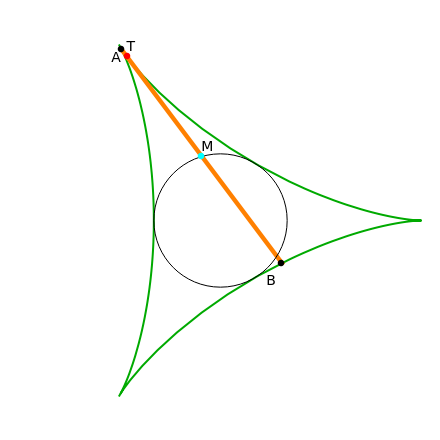The Deltoid is a Kakeya Set
The Deltoid is a Kakeya Set
A circle of radius 1 rolls inside a fixed circle of radius 3 (the fixed circle is shown when "labels" is selected); a point on the circumference of traces out the green curve, called a deltoid (or tricuspoid). Let the tangent to the deltoid at meet the deltoid again at and . Then the midpoint of lies on the circle of radius 1 with center at origin. The length of is 4, so the deltoid is a Kakeya set: a set through which a line segment can be moved back to itself but turned 180°.
C
1
C
1
T
A
B
M
AB
AB
Details
Details
The Kakeya needle problem asks whether there is a minimum area for a region in the plane such that a needle of unit length can be turned through 180°[3].
D
The deltoid is a hypocycloid of three cusps. It was first studied by Euler in 1745. The curve is also called a Steiner curve[4].
References
References
[1] D. G. Wells, The Penguin Dictionary of Curious and Interesting Geometry, New York: Penguin Books, 1991 p. 52 and p. 129.
[2] E. W. Weisstein. "Deltoid" from Wolfram MathWorld—A Wolfram Web Resource. mathworld.wolfram.com/Deltoid.html.
External Links
External Links
Permanent Citation
Permanent Citation
Izidor Hafner
"The Deltoid is a Kakeya Set"
http://demonstrations.wolfram.com/TheDeltoidIsAKakeyaSet/
Wolfram Demonstrations Project
Published: June 14, 2016

